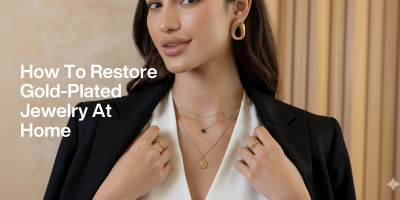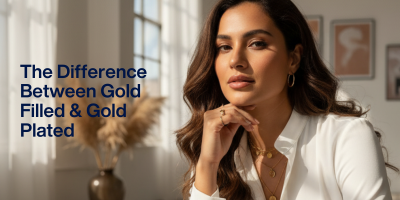When it is about jewelry, we all want that luxurious golden glow without always paying the hefty price tag of solid gold. The good news is that with gold-plated jewelry, this dream of owning glamorous and affordable jewelry can always come true.
However, here comes the tricky part- you start browsing online and notice terms like 10K gold-plated, 14K vs. 18K gold, and 18 karats of gold. And you are like, “Wait, what is the actual difference between these? Isn’t it just gold?”
Well, not exactly because the number “K” makes a huge difference in terms of shade, shine, durability, and overall look. Wondering how? Don’t worry, we are here to break it down together in a simple, fun way, so you will know exactly which one to choose.
But First, What Does “Karat” Even Mean?
In case you are wondering what the “k” stands for, it stands for Karat, which measures the purity of gold. Here’s what the karat represents:
- 24K gold = 100% pure gold (soft, bright yellow, but too delicate for everyday jewelry).
- 18K gold = 75% gold + 25% alloy metals (a beautiful balance of purity and durability).
- 14K gold = 58.3% gold + the rest alloy metals.
- 10K gold = 41.7% gold + the majority alloy metals (more durable, but less “gold-looking”).
Gold-plating means, a fine, solid layer of gold bonded to a base metal like 316L surgical-grade stainless steel. So, the karat here doesn’t mean how much gold is in the whole piece; it simply describes the quality of the gold used in that outer layer.
10K Gold-Plated Jewelry- Affordable but Not So Golden
Let’s start with 10k gold plating.
At 41.7% pure gold, 10k has the lowest gold content legally considered “gold” in the jewelry world. Because it’s mixed with a higher amount of other metals, the color is not as rich or warm. Instead, it can look paler or slightly duller compared to higher karats.
Pros of 10k Gold Plating:
- Super affordable.
- Very durable (thanks to the higher alloy content).
- Resistant to scratches.
Cons:
- Not as shiny or vibrant.
- May sometimes appear more “yellowish-white” than rich gold.
- Less hypoallergenic, as those extra alloy metals may irritate sensitive skin.
If you just want a trendy chain or ring that you don’t mind replacing after a season, 10k plating is fine. But if you want a timeless piece that looks expensive, this isn’t the best option.
Check out: How to Take Care of 18K Gold Plated Jewelry
14k Gold-Plated Jewelry: The Balanced Middle Ground
Next up is 14k gold plating, which contains 58.3% pure gold. This is actually the most popular choice in the U.S. for solid gold jewelry because it balances durability with that warm golden shine.
When plated, 14k jewelry gives you a nice, medium-golden tone, not too pale like 10k, but not as rich as 18k. Think of it as the “Goldilocks” option-it sits right in the middle.
Pros of 14k Gold Plating:
- Affordable but looks more luxurious than 10k.
- Decent durability.
- Subtle golden glow, good for daily wear.
Cons:
- Not as bright or rich as 18k.
- Still contains a significant amount of alloys, which may dull over time.
If you are buying a gold-plated watch or a piece you will wear every day, 14k is a solid choice. It won’t scream “luxury” like 18k, but it gives you a polished look without breaking the bank.
18k Gold-Plated Jewelry: The Ultimate Luxe Look
Now let’s talk about the queen of gold plating: 18k.
With 75% pure gold, 18k plating gives jewelry that unmistakable, rich, warm, buttery glow we all associate with luxury. It’s closer to the color of pure 24k gold but with enough alloy metals to make it practical.
If you want your jewelry to look elegant, classy, and timeless, 18k is the way to go. Many high-end fashion brands use 18k gold plating on 316L surgical steel because it instantly makes a piece look more luxurious.
Pros of 18k Gold Plating:
- Stunning, rich golden hue.
- Looks closest to pure gold.
- Hypoallergenic (fewer alloys compared to 10k or 14k).
- Perfect for special occasions and timeless jewelry pieces.
Well, the 18K variety has no cons as such because when you compare a 14k gold vs 18k gold jewelry, you are getting better value for money, and more shine for a fraction of the amount that you would have anyway paid.
Quick Comparison
Still confused between 10k vs 14k gold or 10-karat gold and 18-karat gold? Here’s a quick comparison table to help you decide:
| Feature | 10K gold-plated | 14K gold-plated | 18K gold-plated |
|---|---|---|---|
| Gold Purity | 41.7% | 58.3% | 75% |
| Color | Pale yellow, duller | Moderate warm gold | Rich-deep golden glow |
| Durability | Very durable | Good durability | Reasonably durable |
| Hypoallergenic | Low | Medium | High |
| Price | Cheapest option | Affordable mid-range | Pricier but luxurious |
| Best For | Trendy, short-term wear | Everyday wear | Timeless, classy pieces |
The Verdict
This was everything you needed to know about these three karats of gold-plated jewelry. Among 10, 14, and 18K gold-plated jewelry, the 18K variant is downright the best. 18K gold-plated water-resistant jewelry is like having the best of both worlds because you get to enjoy the look of gold without breaking the bank.
Looking for the best 18K gold-plated pieces that will look stunning on you, whether you are going on a date, solo tripping, or lounging on the chair with your fur pal in a swanky pet parent party? Find adorable and durable 18 karat gold-plated jewelry from our inventory at FURPPL today!










